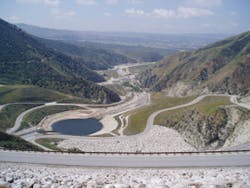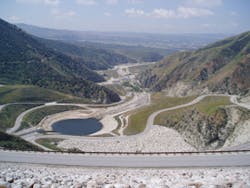Historically, western Riverside County was an agricultural community. During the early years of the county’s history, the region served by Western Municipal Water District (Western) received its water from groundwater sources. As the population in western Riverside County grew, it became evident that relying solely on groundwater recharged by nature was no longer practical. In 1954, regional leaders took the initiative to create the district, in order to be annexed by the Metropolitan Water District of Southern California (MWD) and supplement local water supplies with imported water from the Colorado River Aqueduct, constructed by MWD during the Great Depression to supply southern California with water. During Western’s early years, it delivered water to irrigation systems for the region’s burgeoning citrus industry. By the 1960s, Western began to deliver drinking water to 27 residential users in the Rainbow Canyon area just south of Temecula.
Western provides supplemental water to roughly 24,000 retail and eight wholesale customers, including member agencies within a 527–square mile area of western Riverside County, serving a population of more than 850,000 people. As a member agency of MWD, Western is leading the way in providing clean, reliable water to one of the fastest-growing population centers in the US. Western is also one of five member agencies of the Santa Ana Watershed Project Authority (SAWPA), a regional water resource planning and project implementation organization that has pioneered the concept of Integrated Regional Water Management Plans (IRWMP) in California.
Because of pressure on communities to improve the quality of effluent discharged into the Santa Ana River Basin during the late 1970s, Western began supplying imported water from the State Water Project with a lower mineral content. Western’s service area has an annual precipitation rate of 11 to 14 inches per year, compared to its 56 inches of annual evapotranspiration. This semi-arid climate makes it imperative for water agency managers to implement Water Use Efficiency (WUE) Plans, an area in which Western has become a proven leader.
California’s Water Crisis
California currently faces a significant water crisis, prompted in a large part by a recent federal court ruling ordering a drastic reduction in the amount of water that is pumped from the Sacramento–San Joaquin River Delta in order to protect the endangered Delta Smelt. The majority of imported water Western receives comes from the Sacramento–San Joaquin River Delta via the State Water Project. Given the tremendous vulnerability that California faces with prolonged drought conditions and regulatory issues, it is imperative that the peripheral canal be built immediately in the Delta. This solution is a key long-term priority for Western to ensure water reliability from the Bay-Delta. This action will result in the greatest amount of quality water being delivered to the greatest number of people, farms and industries.
Western Municipal Water District and the San Bernardino Valley Municipal Water District filed for water rights on the Santa Ana River, in 2007. They were granted temporary permits to divert water and have stored over 7,000 acre-feet water in nearby groundwater basins for use during dry years.
The 2005 State Water Plan Update laid out a “Framework for Action” which encourages water managers to look at water plans from a regional perspective. Western swiftly embraced the Framework for Action by implementing its first IRWMP in 2006. Always looking for innovative ways to improve water quality and reliability, Western’s 2008 IRWMP introduced a WUE Master Plan in response to the worsening California water crisis. Western is a strong supporter of regional planning and is a leading participant in SAWPA’s IRWMP process, the One Water One Watershed (OWOW) initiative, and has chaired the WUE pillar in developing and proposing innovative solutions (www.sawpa.org).
Demand Management
Water use efficiency is a key component of Western’s 2008 IRWMP. The majority of Western’s customers are residential, comprising 70% of the total demand for water. Of that number, up to 60% of the water used by residential customers is for outdoor landscaping. Western has implemented a number of water conservation programs to help residential customers reduce water use in their landscapes. Encouraging residents to replace turf with climate-appropriate plants is just one way Western is encouraging long term water use efficiency. Located at Western’s Riverside headquarters is a preeminent water conservation center in the southland–Landscapes Southern California Style, which teaches residents how to landscape their yards using California Friendly, and native plants palettes that save water and money.
In addition to working with individual residents through water use evaluations and audits, “Smart” controller installation, and high-efficiency sprinkler retrofit programs, Western is working with large water users, such as homeowners’ associations and commercial customers, to increase awareness of the many water saving technologies and devices available.
“Water–Use it Wisely” is a regional outreach campaign, instituted in November 2008, with targeted and frequent messages about water use efficiency; messages which are critical to the community. Encouraging wise water use is a key message that Western is highlighting in all of its communications with the community. Because imported water can be unreliable at times and demand for water is increasing over time, Western is committed to ensuring that a robust regional water supply be developed to sustain the future economic viability of our communities.
Western’s Water Supply Portfolio
In anticipation of MWD’s announcement of a regional water shortage of 10%, effective July 2009, and a 19.7% water rate increase, effective September 2009, Western has formed local agency partnerships and is undertaking several projects to increase regional water supply and decrease the area’s dependence on imported water.
The planned Arlington Desalter expansion will increase treatment capacity to produce up to 7,500
acre-feet per year, using innovative technology to remove nitrates from the groundwater supply.
In March 2009, Western and Riverside Public Utilities signed a cooperative water “wheeling agreement” to increase Western’s water supply by up to 6,000 acre-feet of water per year (AF/Y)–approximately 5% of Western’s total imported water supply. In exchange, Riverside Public Utilities will receive $450 per acre-foot of water delivered through its system, plus the ability to purchase up to 1,000 acre-feet of Western’s water. This money will be used to improve the reliability of Riverside’s water delivery system, further developing and utilizing local water resources and reliability in the region. Riverside Public Utilities also has a WUE program called Blue Riverside (www.blueriverside.com) that has proven to be very effective in helping residents to conserve water.
Western has a long tradition of seeking opportunities to increase local water supplies. One good example of Western’s strategic partnerships involves the Seven Oaks Dam, built in 2000. Historically, the water that flowed down the Santa Ana River made its way to the Pacific Ocean and was lost for local use in the upper Santa Ana River watershed. The initial use of the dam was limited to flood control for stormwater runoff.
Because of decreasing water supplies, Western and the San Bernardino Valley Municipal Water District (Valley District) sought to capture and store this water for future use. The agencies filed for water rights on the Santa Ana River in 2007 and are awaiting approval of their application from the state. The districts were granted temporary permits to divert water while these applications are being processed and have stored over 7,000 acre-feet of Santa Ana River water in nearby groundwater basins for use during dry years.
The partnership between Western and Valley District is a good example of the creative ways in which Western is working with other agencies to ensure that local water supplies are increased, thus lessening our dependence of imported water. This arrangement has allowed the two agencies, which serve a combined total of over a million people, to deliver water from Redlands to Temecula.
In order to further increase local water supplies, Western recently joined the Chino Basin Desalter Authority (CDA), a partnership of local agencies, including the Jurupa Community Services District; Santa Ana Water Company; Inland Empire Utilities Agency; and the cities of Chino, Chino Hills, Norco, and Ontario. Western’s CDA partnership with the city of Ontario and Jurupa Community Services District will allow expansion of the Chino II Desalter to increase regional drinking water supply by 10,600 AF/Y. This expansion includes building new wells, groundwater treatment, and distribution facilities in the lower Chino Basin.
The planned Arlington Desalter expansion will increase treatment capacity to produce up to 7,500 AF/Y and will use innovative technology to remove nitrates from the groundwater supply. Western will be among the first in the nation to use a full-scale biologically active denitrification facility to remove nitrates from groundwater and to produce drinking water. Western will also increase facility capacity using brine concentration to recover more water through the reverse osmosis process used to remove salts from the groundwater. The brine concentration process will increase the overall efficiency of the plant from 80% to 95% recovery while reducing brine discharges from the plant by 1 million gallons per day. The Arlington Desalter has been in operation since 1990 and functions to clean up the groundwater in the Arlington Basin that is located in western Riverside County and is part of Western’s service area. This project is an important step in ensuring the long-term reliability of local water supplies.
The Western Water Recycling Facility expansion is the largest project undertaken in the District’s 50–plus year history to date. The project will increase recycled water treatment capacity from 1 to 3 million gallons per day by summer 2010, a testimony to Western’s commitment to increase local water supplies and lessen dependence on imported water. The recycled water is used for large commercial customers such as golf courses and cemeteries. Expansion of the treatment plant will allow Western to treat and deliver recycled water to tertiary levels, thereby adding more local water to the region for irrigation and groundwater recharge, further expanding Western’s water supply portfolio.
From working with stakeholders in the region to collaborate on water supply projects, to assisting policy makers in Sacramento, Western has positioned itself as a leader in the water use efficiency arena.
“Earth Night in the Garden” teaches about water efficient technologies and techniques.
Western is working towards developing more reliable local water sources such as the Western Water Recycling Facility.
Western’s Promise
In the wake of California’s water crisis, Western is working on many fronts to ensure customers have reliable sources of clean drinking water. These measures include promoting WUE programs with sustained outreach to ensure customers have the tools they need to use water wisely. Community outreach venues, such as “Earth Night in the Garden,” bring people of all ages together to learn more about water efficient technologies and techniques.
By partnering with other local and regional agencies, Western is working towards developing more reliable local water sources, such as the Western Water Recycling Facility, the Chino Desalters, and the Arlington Desalter. These large-scale projects will substantially increase the amount of local water that is available. On the advocacy front, Western is committed to ensuring that local voices are heard in Sacramento and Washington D.C. Advocating for a peripheral canal is a major legislative strategy for Western. Western works on many fronts to ensure that the District’s customers are well served at the local, state, and federal level. These actions are all part of the District’s commitment to ensure the region continues to have reliable, clean, and, most important, local drinking water sources. Over 50 years later, Western continues to deliver on that promise.
Life in the arid Southwest is changing. Dwindling water supplies from traditional sources are forcing water agencies to assess how they use and reuse each and every drop of water. In southern California, a significant amount of the water used comes from the north via the State Water Project or from the East through the Colorado River. Water supplies from both of these sources have declined in reliability and yield. In response, Western is at the forefront of seeking ways to increase local water supplies, while decreasing the region’s dependence on imported water sources.



